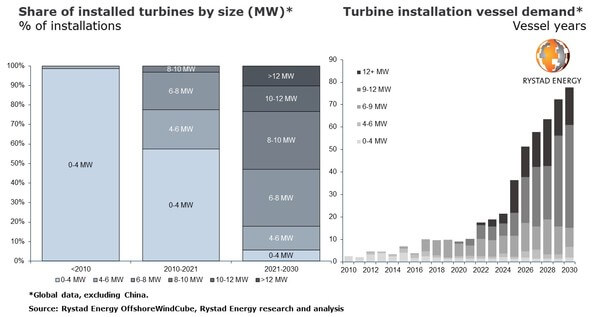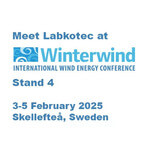News Release from Rystad Energy
Wind Industry Profile of
Super-sized offshore wind installations could suffer bottlenecks from 2024 as vessels remain lightweight
Wind turbines globally, excluding China, have experienced a growth spurt in recent years, rising from an average of 3 megawatts (MW) in 2010 to 6.5 MW today, with the largest in operation clocking in at 10 MW. Turbines larger than 8 MW accounted for just 3% of global installations between 2010 and 2021, but that percentage is forecast to surge to 53% by 2030.
As the energy transition accelerates, demand for offshore wind turbine installation vessels worldwide, excluding China, will rocket from 11 vessel years in 2021 to almost 79 vessel years by 2030. The need for installation vessels for turbines larger than 9 MW, which was nonexistent in 2019, will grow significantly by the end of the decade and reach 62 vessel years in 2030.
“When turbines were smaller, installation could be handled by the first-generation fleet of offshore wind vessels or converted jackups from the oil and gas industry. However, as operators continue to favor larger turbines, a new generation of purpose-built vessels is required to meet demand,” says Martin Lysne, Rystad Energy rigs and vessels analyst.

Learn more in Rystad Energy’s VesselCube (Image: Rystad Energy)
Unable to install new and larger turbines, the first-generation installation fleet has now transitioned into maintenance and repair services for installed turbines, while operators have upgraded other vessels’ cranes in order to remain competitive in the installations market.
The global picture
In Europe, Asia (excluding China) and the emerging US market, turbine sizes are ramping up towards 2025 and beyond. Europe’s first commercial 10 MW turbine was installed in December 2021 at Scotland’s Seagreen offshore wind farm by Cadeler’s Wind Osprey. A total of 114 turbines are lined up for the 1.1 GW North Sea project. At the Vineyard Wind development in the US, 13 MW turbines will be installed by DEME’s Sea Installer after its crane upgrade. Jan De Nul’s newbuild Voltaire will debut at the Dogger Bank wind farm in the UK, installing 13 MW turbines. Cadeler is contracted to install 14 MW turbines at the Sofia wind farm in the UK, and 14 MW turbines will also be installed at the Hai Long development in Taiwan. In addition, 15 MW turbines will be installed at the EnBW He Dreiht project in Germany, while many US developments, such as Coastal Virginia and Empire Wind, are also looking to install 15 MW turbines. Despite installing one 10 MW turbine at the Xinghua Bay wind farm last year, China is expected to lag behind Europe in average turbine size up to 2030. Although China will install some larger turbines in the coming years, most installations are expected to measure between 6 MW and 8 MW.
Vessel demands
Larger turbine installations require stronger cranes on installation vessels to lift heavier materials higher, and only a handful of purpose-built vessels available worldwide can install 10 MW+ turbines. As a result, many vessels have moved from Europe to China, where lower crane capacity vessels are still in high demand. Jan De Nul’s Taillevent was sold to China last year, and DEME’s Apollo has also recently been renamed and reflagged to work in the Chinese market. Excluding China, demand for 12 MW+ capable installations vessels is set to increase rapidly, taking a larger share of overall demand.
Out of the current fleet of purpose-built vessels, only a handful of units can install 10 MW+ turbines, and none are currently able to install 14 MW+ turbines. This will change towards 2025 as newbuilds start to be delivered and existing vessels get crane upgrades. Fred Olsen Windcarrier, DEME and Cadeler are all planning crane upgrades, with Bold Tern, Brave Tern, Sea Installer, Wind Osprey and Wind Orca all upgrading to 1,600-tonne cranes between 2022 and 2024, with options for other vessels to be upgraded. In addition to the purpose-built vessels, some semisubmersible heavy lift vessels are being proposed for turbine installation, such as Heerema Marine Contractors’ Thialf and Sleipnir. Generally considered too large and inefficient for installing the smaller turbines of the past, these vessels have instead landed work in the offshore wind industry installing substations and heavy foundations. However, as the size of turbines increases, these units will fit right into the large cranes of heavy lift vessels such as Thialf and Sleipnir. The Thialf will install 27 turbines – each measuring 9.5 MW – at the Arcadis Ost wind farm in the Baltic Sea in 2023, becoming the first floating vessel to install commercial wind turbines of this size. Heerema has said both the Thialf and Sleipnir are already capable of installing 15 MW+ turbines and, with some adjustments, these vessels could even install 20 MW turbines.
Vessels built early this decade are already becoming outdated as turbines grow, making owners reluctant to commit to expensive newbuilds that could be obsolete before they are profitable. The cost to manufacture an installation vessel capable of installing 14 MW+ turbines ranges from $300 million to $500 million, but owners are opting for even bigger cranes in the hope of staying competitive for longer.
A 1,500-tonne crane capacity with 150 meters lifting height is generally considered the requirement to install 14 MW+ turbines. Considering current pending orders, excluding vessels assumed to be operating solely in China, all 11 vessels are installing cranes of more than 2,000 tonnes, with some even opting for 3,000 tonnes. Owners have one eye on the future, with some already stating they will be ready for 20 MW turbines by the end of the decade.
For more analysis, insights and reports, clients and non-clients can apply for access to Rystad Energy’s Free Solutions and get a taste of our data and analytics universe.
- Source:
- Rystad Energy
- Author:
- Press Office
- Link:
- www.rystadenergy.com/...
- Keywords:
- Rystad Energy, offshore, wind turbine, installation, crane, vessel, heavy, load, lightweight, China, global, decade, demand, Jan De Nul



























